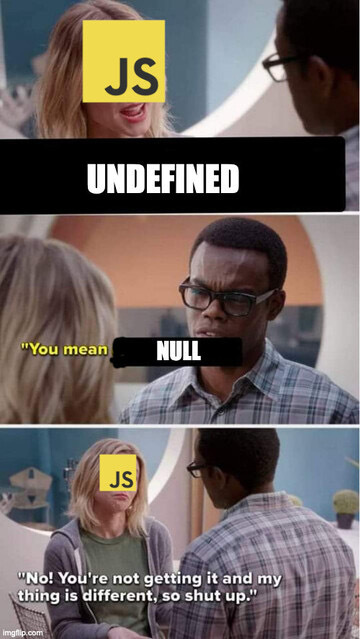- cross-posted to:
- [email protected]
- cross-posted to:
- [email protected]
That one wasn’t the one I had issues with, since the concept is essentially the same across all languages. We say it’s false because we can’t conclusively say that it’s true. Same as the reason why null != null in SQL.
It also makes a lot of conditional expressions less complicated because comparisons of all kind against NaN return false.
It’s C
yep, because it’s two different instances of an object
Wtf? Min > Max???
Math.min isn’t the minimum integer; it’s the minimum of a list (and max visa versa)… the min/max of an undefined list is the same… IDK what it is, but this probably the most reasonable of the “WTFs” they could have put there i think… other languages would throw an exception or not compile (which JS definitely SHOULD do instead of this, buuuuut lots of JS has aversions to errors)
*edit: okay the curiosity was killing me: Math.min() is Infinity and Math.max() is -Infinity
No, it’s Javascript, keep up
C
C++
The one option that is mandated by an ISO standard.
Besides, if max and min are going to have a value without any parameter, it has to be exactly those Javascript uses. Unless you have a type that define other bounds for your numbers. And null always have a pointer type (that is object in Javascript), for the same reason that NaN always have a number type.
The only one that is bad on that list is D.
typeof null === "object"was actually a bug in the early implementations, and they decided to keep it in the spec: https://2ality.com/2013/10/typeof-null.html(see the comment from Brendan Eich)
Tony Hoare: “Introducing NULL was a billion-dollar mistake”
Brendan Eich: “Hold my undefined”

We had one
null, yes. But what about secondnull?
Maybe D is too single quotes
0 == ''“This comparison appears to be unintentional”
D…Deez nutz!
If you thought this was fun you might like https://jsisweird.com/ with similar questions
I love the two lonely downvotes on this.
Merging the upvotes and downvotes is the best option
nah, it’s more fun this way.
Option C. The value
NaNcompares unequal to every value, even itself. This breaks one of the rules of what equality even means (that every value must be equal to itself, the “reflexivity” axiom). It is for this reason (among others,equality“partial” equivalence between values of different types? 🤮) Rust needed to havePartialEq. See IEEE 754 for more details.Why
typeof nullis"object"? Because it is defined so: https://tc39.es/ecma262/multipage/ecmascript-language-expressions.html#sec-typeof-operator5. If
valisnull, return"object".As for the rationale behind the choice, it might have something to do with “Prototypal inherience” the language has. https://tc39.es/ecma262/multipage/overview.html#sec-objects
Every object created by a constructor has an implicit reference (called the object’s prototype) to the value of its constructor’s “prototype” property. Furthermore, a prototype may have a non-null implicit reference to its prototype, and so on; this is called the prototype chain.
We can understand this to mean that prototype chains are
nullterminated ;)For example:
> Object.getPrototypeOf({}) === Object.prototype true > Object.getPrototypeOf(Object.getPrototypeOf({})) null > Object.getPrototypeOf(null) TypeError: not an objectUhh…
Now, let’s go to some abstract algebra. All good (closed) binary operations we deal with have an identity or neutral value. For example: addition has 0, multiplication has 1, boolean
andhastrue, booleanororxorhasfalse. Performing these operations with the neutral value does not change the other operand: for example,x + 0 == x,a * 1 == a,true && b == band so on. If you admitminandmaxas operators, you can see why ∞ and -∞ are the neutral values, respectively:min(∞, x) == xandmax(-∞, y) == yfor every (real) value of x and y.For mathematicians: closed, because the operators are maps
S × S →S, to exclude<,etc. as they map toBool. Oh, they are relations, bla bla … real numbers, we don’t want to deal with other total orders here, there should be some way to call orders that have both top and bottom values, complex numbers don’t have orders (usual ones, are there unusual ones?), bla bla blaAs for the last one, sigh… https://tc39.es/ecma262/multipage/abstract-operations.html#sec-islooselyequal
Oh, that
!s in there aren’t booleannot… they are… (looks it up) argh, read it yourself https://tc39.es/ecma262/multipage/notational-conventions.html#sec-returnifabrupt-shorthandsMe, wasting my time explaining an ECMAScript meme… I be like, I need to somehow justify the time spent learning about all of these… it was the language I started my programming journey with… sigh
C, because yes.
I’d say C too because that’s the only one that would be True in a normal programming language and this is javascript so…
It’s not true in a normal programming language. If it is true in yours, you should stop using it immediately.
A non type should be a type. It should be of the type none. And it is in good script languages like Python so I don’t know why you think it shouldn’t.
They say a picture is worth a thousand words.

That’s a Numpy type, not a Python typesm, try a=None b=None a==b
probably not true in most other langauges. although I’m not well versed in the way numbers are represented in code and what makes a number “NaN”, something tells me the technical implications of that would be quite bad in a production environment.
the definitive way to check for NaN in JS would probably be something like
// with `num` being an unknown value // Convert value to a number const res = Number(num); /* * First check if the number is 0, since 0 is a falsy * value in JS, and if it isn't, `NaN` is the only other * falsy number value */ const isNaN = res !== 0 && !res;NaN is a special floating point value. https://en.wikipedia.org/wiki/IEEE_754
It’s weird but it makes sense why it was chosen to be this way.
Another way to check whether a number is
NaN:const isNaN = res !== res;As
NaNis the only value out there that is not equal to itself. See my other comment on this post for more: https://programming.dev/comment/17221245This comparison should work in every programming language out there that implements/respects/uses IEEE 754 floating point numbers.
Probably B?
I’m no expert and I know that javascript is full of wtf moments, but please… Let it be B
It’s not gong to be B, it’s it.
It’s C, NaN is never equal to itself in floating point, that’s not just a JS thing.
Yep, it’s C
No, it’s JS
It is true. Math.min() returns positive Infinity when called with no arguments and Math.max() returns Negative Infinity when called with no arguments. Positive Infinity > Negative Infinity.
Math.min() works something like this
def min(numbers): r = Infinity for n in numbers: if n < r: r = n return rI’m guessing there’s a reason they wanted min() to be able to be called without any arguments but I’m sure it isn’t a good one.
I’m guessing there’s a reason they wanted min() to be able to be called without any arguments but I’m sure it isn’t a good one.
It not a totally unreasonable definition. For example it preserves nice properties like
min(a.concat(b)) == min([min(a), min(b)]).Obviously the correct thing to do is to return an optional type, like Rust does. But … yeah I mean considering the other footguns in Javascript (e.g. the insane implicit type coersion) I’d say they didn’t do too badly here.
So, the language isn’t compiled (or wasn’t originally) so they couldn’t make
min()be an error that only a developer saw, it has to be something that the runtime on the end-user system dealt with. So, it had to be assigned some value. Under those restrictions, it is the most mathematically sound value. It makes miniumum-exactly-2(x, min(<…>)) be exactly the same as min(x, <…>), even when the “<…>” has no values.As a developer, I see a lot of value in static analysis, including refusing to generate output for sufficiently erroneous results of static analysis, so I don’t like using JS, and the language that I tinker with will definitely have a separate compilation step and reject the equivalent of
min(). But, if I HAD to assign something like that a value, it probably would be a representation of infinity, if we had one (probably will due to IEEE floats).HTH
The language not being compiled has nothing to do with error handling. You could have a
minfunction that operates on dynamic arrays (e.g. std::min_element in C++ or min() in Python).
I also am not familiar with javascript anymore…precisely because of this, exact, insane bullshit.
B… and/or C… evaluating as FALSE are the only things that… should even kind of make sense, according to my brain.
Though at this point in my life, I have unironically had a good number of concussions and contusions, so … well you’d think that would help with JS development.
Javascript is insanity, and I am still convinced it is at least 40% responsible for Notch losing his goddamned mind.
‘null’ is somehow an object. because fuck you, thats why!
Is… 0 == ‘’ … is that two single quotes ’ ’ ?
Or one double quote " ?
If… it is one double quote… that wouldn’t even evaluate, as it would just be an empty string without a defined end…
But if it was two single quotes… that would just be a proper empty string… and because of forced type coercion, both 0 and ‘’ are FALSE when compared with ==, but not when compared with ===, because that ignores forced type coercion…
https://www.w3docs.com/snippets/javascript/when-to-use-double-or-single-quotes-in-javascript.html
Oh my fucking god WHY?!
Just fucking use one special character to delimit strings!
Don’t have two that don’t work together and also behave differently even when you pick just one of them… GraaaghhH!
brb, figuring out where Larry Ellison lives…
It’s pretty easy to avoid all of these, mostly by using ===. Null being an object is annoying and is one of the reasons ‘typeof’ is useless, but there are other ways to accomplish the same thing.
JavaScript has a lot of foot guns, but it’s also used by literally everyone so there is a lot of tooling and practice to help you avoid them.
I don’t think my sanity can take all of these explanations.
Though I just spotted one that’s worse than null being an object …
typeof Nan "number"I mean, come on… it’s even in the fucking name!
Number = IEEE-754 double precision float, which includes NaN, so it makes sense
Douglas Crockford has a whole chapter of these in his latest book. There’s also this classic video.
Notch? The guy who codes in java?
That’s just short for JavaScript, isn’t it?
Java is actually twice faster cause the name is twice shorter
Math.min() == Infinity Math.max() == -InfinityWtf is going on JS…
edit: https://developer.mozilla.org/en-US/docs/Web/JavaScript/Reference/Global_Objects/Math/min
Its the min value of the input params, or Infinity.
Math.min.length is 2, which weakly signals that it’s designed to handle at least two parameters
Why would they even define this value?
Note: I’m not a js dev, do most functions have length?
I am also not a JS dev, we possibly aren’t brain damaged enough to understand the perfection.
Most people don’t use JS because they think it’s perfect… they use it because it’s the language that works on web browsers… or because thier coworkers made something in it… or because the library that does what they want uses it…
For such a terrible language, it really has staying power…
JS is the machine code of the web. Fewer and fewer people might write it directly, but it will live as long as the web platform does.
Until some browser can make pages with Python, maybe.
I develop with JS? All I can say is I need more brain damage to understand where is out
Just keep developing with it, you’ll get CTE soon.
Fun fact, even tho B is False,
Math.min > Math.maxis trueThat is not a fun fact. How do I unsubscribe :D
But B is true

















